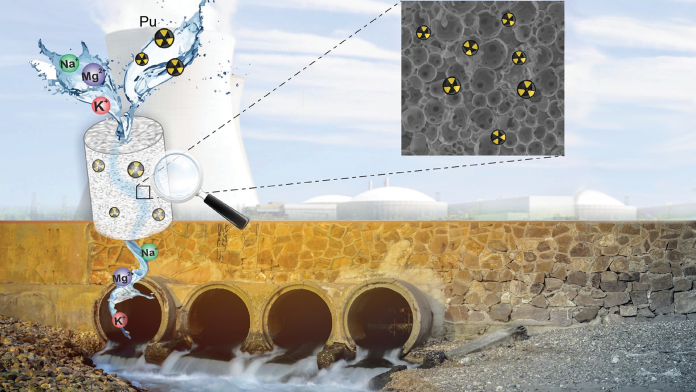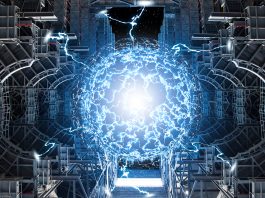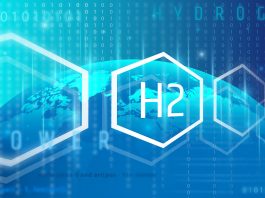A study considering a new strategy for treating radioactive effluents based on using mesoporous silicas is under way. This material would allow separation and encapsulation of radionuclides following pore collapse by irradiation.
Mesoporous silicas (SBA-15, MCM-41) were first discovered in the 1990s. Due to their huge specific surface area, which can reach 1,000m2/g, they have been the subject of numerous studies for various applications in the fields of catalysis, CO2 encapsulation, and depollution.
These materials, however, were not suitable for the treatment of radioactive effluent.1,2 A new strategy for this treatment relies on the use of a functionalised porous support. This support would allow both the separation of radionuclides (RN) by a selective organic function grafted on its surface, and their encapsulation after collapse of the porosity, leading to a radionuclide conditioning wasteform. Indeed, the chemical composition of mesoporous silica is similar to the glassy matrices used in the conditioning of high-level nuclear waste and, as such, could be considered an effective material for this application. Several methods can be envisaged to obtain this collapse, such as compression and chemical plugging.
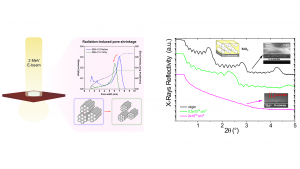
Recent work carried out at the Institut de Chimie Séparative de Marcoule in France has shown that irradiation damage caused by external irradiation (ions, electrons) leads to the collapse of the mesoporous structure. More precisely, mesoporous silica powders compacted in the form of 1mm pellets were irradiated by 2 MeV electrons, characteristic of the beta decay of a fission product. Thin films of 100nm thick mesoporous silicas, deposited on silicon wafers, were irradiated by low-energy gold ions (0.5 MeV) in order to simulate the damage caused by the recoil nucleus associated with the alpha decay of an actinide. These varying geometries of the samples led to the use of adapted characterisation techniques to probe the evolution of the porous network, namely nitrogen adsorption isotherms (BET, BJH method) for the pellets (Fig. 1a), and X-ray reflectometry (XRR) for the thin films (Fig. 1b). In all the irradiation conditions studied, a collapse of the porous network was observed; a decrease of about 80% of the volume for a dose of 5GGy during irradiations by electrons of 2 MeV.3 This indicated a total collapse of the porosity for damage of about 1 dpa during irradiations by gold (Au) ions of 0.5MeV.4,5 The dpa represents the number of times, on average, an atom is displaced from its lattice site as a result of energetic particle bombardment.
From an application point of view, this solution would be well-suited to the decontamination of liquid effluents containing actinides (Pu), frequently encountered in the nuclear industry. The ANR AUTOMACT6 project, funded by the National Research Agency, aims to study this concept. We will detail below the different stages of this work.
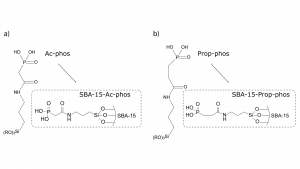
Functionalisation of silica surfaces by phosphonate groups
Silica SBA-15 grafted with phosphonate ligands, allowing the recovery of actinides contained in an aqueous effluent, were synthesised according to the procedures reported by Fryxell.7 The ligand Ac-phos and Prop-phos, which has amide and phosphonic acid functions, were used. All ligands are linked to the silicon atom by an alkyl chain containing three carbon atoms and the amide function. The structure of the grafted mesoporous silicas and the corresponding ligands (before their grafting) is shown in Fig. 2. The silica surface’s functionalisation considerably reduces its specific surface from about 700m2/g to 300m2/g.
Sorption of actinides by functionalised silica
Initially, sorption experiments were carried out to test the adsorption capacity of thorium by a silica functionalised with phosphonate groups. These tests were continued with solutions containing plutonium, which presents a specific activity much higher than that of thorium, in particular plutonium 238, to study the silica porosity’s closure by the irradiation damage caused by the alpha disintegrations of plutonium. The obtained results presented in Fig. 3 show a comparable efficiency of these ligands for Pu or Th radionuclides.
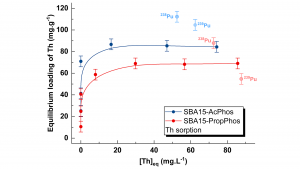
Self-irradiation and structural changes
As discussed previously, particle irradiations (ions, electrons) induce the collapse of silicas’ mesoporosity. Ballistic interactions with 0.5 MeV Au ions are very efficient for that. Under the reported operating conditions, the mesoporous silica is completely densified for a damage of about 1dpa. The objective of the Automact project is to assess whether the self-irradiation caused by the alpha decays of plutonium can induce the same collapse. Actinide test sorption showed that mesoporous silicas can adsorb about 10wt.% of plutonium. This Pu loading makes it possible to obtain radiation damage of 1 dpa in approximately one year for samples doped with isotope 238Pu. This is why the SBA15-Pro-phos-238Pu sample was chosen to study the evolution of mesoporosity under self-irradiation. This sample was charaterised as small-angle X-ray scattering technique (SAXS), which is accessible on the SOLEIL synchrotron’s MARS beamline located in France.
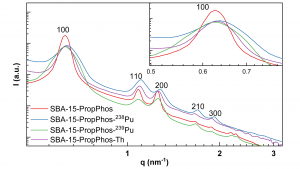
The first analysis took place in October 2022 and showed a little shift in the position of the (100) peak which can be attributed to a densification of the porous silica network (Fig. 4). This result has to be confirmed; two experiments are scheduled for March 2023 and in the autumn of 2023.
Concluding remarks
This study has gone some way towards enhancing the potential application of the process of closing porosity by self-irradiation, and developing the ‘separation/conditioning’ strategy for the decontamination of radioactive effluents. As a first step, the functionalised porous support of the silica would be used to capture the radionuclides, and in the second step, it would act as a conditioning matrix. The results that will be obtained in 2023 will make it possible to clarify the validity of this concept and determine the kinetics of closure of the porosity. At the same time, we believe that the high plutonium capture capacity (10wt.%) of the studied materials (SBA15-AcPhos/PropPhos) will be valuable in solving the difficulty of continuous decontamination processes for radioactive effluents.
References
1 Zur Loye, H.-C., T. Besmann, J. Amoroso, K. Brinkman, A. Grandjean, C. H. Henager, S. Hu, S. T. Misture, S. R. Phillpot, N. B. Shustova, H. Wang, R. J. Koch, G. Morrison and E. Dolgopolova, Chem. Mater. 30, 4475-4488 (2018)
2 Makowski, P., X. Deschanels, A. Grandjean, D. Meyer, G. Toquer and F. Goettmann, New J. Chem. 36, 531-541 (2012)
3 Lin, J., G. Toquer, C. Grygiel, S. Dourdain, Y. Guari, C. Rey, J. Causse and X. Deschanels, Microporous Mesoporous Mater. 328, 111454 (2021)
4 Lou, Y., S. Dourdain, C. Rey, Y. Serruys, D. Simeone, N. Mollard and X. Deschanels, Microporous Mesoporous Mater. 251, 146-154 (2017)
5 Lou, Y., G. Toquer, S. Dourdain, C. Rey, C. Grygiel, D. Simeone and X. Deschanels, Nucl. Instrum. Methods Phys. Res. B 365, 336-341 (2015)
6 Project-ANR-18-CE05-0016, AUTOMACT: Solid fixation and auto-conditioning of actinideelements coming from contaminated liquid outflows (2018) https://anr.fr/Project-ANR-18-CE05-0016
7 Fryxell, G. E., Y. Lin, S. Fiskum, J. C. Birnbaum, H. Wu, K. Kemner and S. Kelly, Environ. Sci. Technol. 39, 1324-1331 (2005)
Please note, this article will also appear in the thirteenth edition of our quarterly publication.

